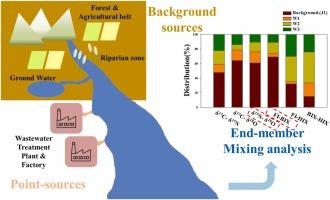Quantifying contributions from unmonitored point-source discharges in an urban river using optical and nitrate isotopic tracers under dry-weather conditions
IF 7.1
2区 环境科学与生态学
Q1 BIOTECHNOLOGY & APPLIED MICROBIOLOGY
引用次数: 0
Abstract
Small-scale wastewater treatment facilities in urban streams often operate under less stringent management, yet their contributions to organic pollution can significantly impact aquatic ecosystems. Continuous monitoring of these discharges remains challenging, necessitating prompt assessment methods. This study applies an end-member mixing analysis (EMMA) approach using stable isotope ratios and optical indices to estimate the contribution of organic matter from small, unidentified point sources. To simplify source attribution and improve methodological efficiency, background DOM—primarily from baseflow and natural organic inputs—was treated as a single end-member. This approach reduces the complexity of end-member sampling while maintaining robust estimates of unknown point-source contributions.
Wastewater discharges from a swine wastewater treatment plant and two food-processing facilities were evaluated for their downstream impact. The EMMA model demonstrated that fluorescence index (FI) and biological index (BIX) provided the most reliable estimates of point-source contributions at downstream sites, yielding consistent results with both measured loading data and model outputs based on the dual nitrate isotope pair (δ¹⁵N-NO₃ - δ¹⁸O-NO₃). However, further downstream, the isotopic model yielded more robust assessments, likely due to its lower susceptibility to biogeochemical alternations during DOM transport compared to the spectroscopic indices. This study demonstrates the effectiveness of optical and isotopic tracers for point-source attribution in urban watersheds, particularly in irregularly monitored or unmonitored settings.

在干旱天气条件下,使用光学和硝酸盐同位素示踪剂量化城市河流中未监测点源排放的贡献
城市河流中的小型废水处理设施通常在不太严格的管理下运行,但它们对有机污染的贡献可能会显著影响水生生态系统。持续监测这些排放仍然具有挑战性,需要及时采取评估方法。本研究采用端元混合分析(EMMA)方法,使用稳定同位素比率和光学指数来估计来自小型、未知点源的有机物的贡献。为了简化来源归属和提高方法效率,背景dom(主要来自基流和天然有机输入)被视为单个端元。这种方法降低了端元采样的复杂性,同时保持了对未知点源贡献的稳健估计。评估了一个养猪废水处理厂和两个食品加工厂的废水排放对下游的影响。EMMA模型表明,荧光指数(FI)和生物指数(BIX)提供了最可靠的下游站点点源贡献估计,与测量的负载数据和基于双硝酸盐同位素对(δ¹N-NO₃- δ¹⁸O-NO₃)的模型输出结果一致。然而,在进一步的下游,同位素模型得出了更可靠的评估,这可能是因为与光谱指数相比,它对DOM运输过程中生物地球化学变化的敏感性较低。这项研究证明了光学和同位素示踪剂对城市流域点源归属的有效性,特别是在不定期监测或未监测的环境中。
本文章由计算机程序翻译,如有差异,请以英文原文为准。
求助全文
约1分钟内获得全文
求助全文
来源期刊

Environmental Technology & Innovation
Environmental Science-General Environmental Science
CiteScore
14.00
自引率
4.20%
发文量
435
审稿时长
74 days
期刊介绍:
Environmental Technology & Innovation adopts a challenge-oriented approach to solutions by integrating natural sciences to promote a sustainable future. The journal aims to foster the creation and development of innovative products, technologies, and ideas that enhance the environment, with impacts across soil, air, water, and food in rural and urban areas.
As a platform for disseminating scientific evidence for environmental protection and sustainable development, the journal emphasizes fundamental science, methodologies, tools, techniques, and policy considerations. It emphasizes the importance of science and technology in environmental benefits, including smarter, cleaner technologies for environmental protection, more efficient resource processing methods, and the evidence supporting their effectiveness.
 求助内容:
求助内容: 应助结果提醒方式:
应助结果提醒方式:


